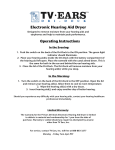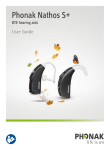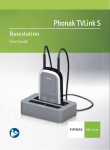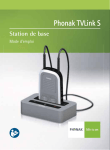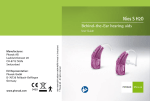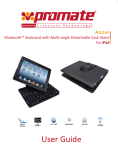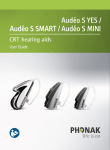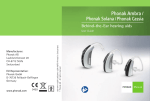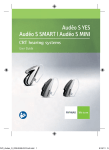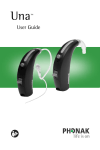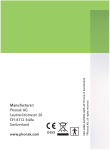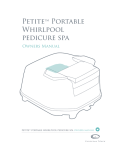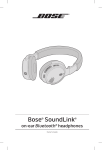Download User Manual Ambra Solana Cassia M H20
Transcript
M H2O hearing aids User Guide Contents 5 2. Important safety information: Please read before operating your hearing aid for the first time 6 2 1. Welcome Hazard warnings 6 Information on product safety 8 3. Hearing aid description 10 4. Step-by-step instructions for using the hearing aid 13 Step 1. Getting to know your hearing aid 13 Step 2. Battery preparation 15 Step 3. Inserting the battery 15 Step 4. Turning on the hearing aid 16 Step 5. Inserting the hearing aid 17 Step 6. Adjusting the volume control behind the ear 23 Step 7. Selecting the hearing program behind the ear 24 Step 8. Removing the hearing aid 25 Step 9. Turning off the hearing aid 27 Step 10. Changing the battery 28 Step 11. Changing the battery in hearing aids with a secured battery compartment 28 5. Care and maintenance 30 6. Troubleshooting 33 7. Wireless accessories and FM systems 35 8. Service and warranty 37 Local warranty 37 International warranty 37 Warranty limitations 37 9. Compliance information 38 10. Information and explanation of symbols 41 3 1. Welcome Your new hearing aid is a premium Swiss quality product. It was developed by Phonak, one of the world‘s leading companies in hearing technology. Your hearing aid offers the most modern digital hearing technology currently available on the market. Please read these user instructions thoroughly in order to benefit from all the possibilities your new hearing aid has to offer. With proper use and care, you will be able to enjoy your hearing aid for many years to come. If you have any questions, please consult your hearing care professional. Phonak - life is on www.phonak.com 0459 5 2. Important safety information Please read the information on the following pages before using your hearing aid. A hearing aid will not restore normal hearing and will not prevent or improve a hearing impairment resulting from organic conditions. Infrequent use of a hearing aid does not permit a user to attain full benefit from it. The use of a hearing aid is only part of hearing habilitation and may need to be supplemented by auditory training and instruction in lipreading. 2.1 Hazard warnings Use only hearing aids that have been specially programmed for you by your hearing care professional. Other hearing aids may be ineffective and may, in certain cases, damage your hearing. Changes or modifications to the hearing aid that were not explicitly approved by Phonak are not permitted. Such changes may damage your ear or the hearing aid. 6 Hearing aid batteries are toxic if they are swallowed! Keep out of reach of children and pets. If batteries are swallowed, consult your physician immediately! If you feel pain in or behind your ear, if it is inflamed, if skin irritation or accelerated accumulations of ear wax occur, please check with your hearing care professional or physician. In very rare cases, the dome can remain in your ear canal when removing the hearing tube from the ear. In the unlikely case that the dome does get stuck in your ear canal, it is strongly recommended to see a physician for safe removal. Hearing programs in the directional microphone mode reduce background noises. Please be aware that warning signals or noises coming from behind, e. g. cars, are partially or entirely suppressed. The hearing aid contains small parts which can be swallowed by children. 7 2. Important safety information External devices may only be connected if they have been tested in accordance with corresponding IECXXXXX standards. Only use accessories approved by Phonak AG. 2.2 Information on product safety Your hearing aid is resistant to water, sweat and dust under the conditions listed in chapter 5. After exposure to any of these elements the hearing aid must be rinsed in fresh water and dried. Protect your hearing aid from heat (never leave it near a window or in the car.) Never use a microwave or other heating devices to dry your hearing aid. Ask your hearing care professional about suitable drying methods. When you are not using your hearing aid, leave the battery compartment open so that any moisture can evaporate. Make sure that you always completely dry your hearing aid after use. Store the hearing aid in a safe, dry and clean place. 8 Do not drop your hearing aid! Dropping onto a hard surface can damage your hearing aid. Always use new batteries for your hearing aid. You can return used batteries to your hearing care professional. Remove the battery if you are not using your hearing aid for a long period of time. X-ray radiation (e. g. CT scans, MRI scans) may adversely affect the correct functioning of your hearing aids. We recommend that you remove them before undergoing X-ray procedures and keep them outside the room. Do not use your hearing aid in areas where electronic equipment is prohibited. 9 3. Hearing aid description The M H2O can be adapted with a variety of earmolds. On the following pages use the labeled drawings to identify the earmold that you use. Your hearing aid uses a size 13 battery. 10 Option A: with classic earmold 3 2 1 4 5 0 / 0 1 2 3 4 5 / Right or left indicator (right=red, left=blue) Battery compartment with ON/OFF switch Push button Microphone input Hook/sound output Hearing tube Classic earmold 11 3. Hearing aid description Option B: with dome 4 6 7 8 9 12 Hearing tube Earmold: Dome Retention Earmold: SlimTip Removal handle Option C: with SlimTip 4 4 6 8 7 9 4. Step-by-step instructions for using the hearing aid The following chapter provides step-by-step instructions on how to use your hearing aid. Please follow these steps carefully. In the drawings, the parts that are particularly important for each step are shown in green. Step 1. Getting to know your hearing aid Take the hearing aid in your hand and try out the hearing aid controls. This will make it easier for you to feel and operate the controls later on when wearing the hearing aid. 13 4. Using the hearing aid Your hearing care professional can configure your hearing aid (push) button as either a volume control or a program selector. To increase the volume, press the button on your right hearing aid. To decrease the volume, press the button on your left hearing aid (Fig. 1a). Decrease volume Left hearing aid Increase volume Right hearing aid Fig. 1a In order to change a hearing program, press the button displayed (Fig. 1b). Fig. 1b 14 Step 2. Battery preparation Remove the protective foil from the new battery (Fig. 2). Wait for two minutes before inserting to activate the battery. Fig. 2 Step 3. Inserting the battery Take the hearing aid in your hand (Fig. 3a) and open the battery door. Insert the battery so that you see the + symbol on the battery (Fig. 3b). Fig. 3a Fig. 3b 15 4. Using the hearing aid Step 4. Turning on the hearing aid Switch on the hearing aid by closing the battery compartment (Fig. 4). Fig. 4 Open and close the battery compartment gently and carefully. Check if you feel resistance when closing the battery compartment. Check to make sure the battery is correctly inserted and in the correct direction. If the battery is inserted the wrong way, the hearing aid will not work and the battery compartment can be damaged. 16 The hearing aid is now switched on. It can take up to 15 seconds before it starts. (When you wear the hearing aid, you will hear an acoustic signal). Step 5. Inserting the hearing aid This step shows you how to correctly insert the hearing aid. The instructions apply for all hearing aid models. The type of earmold determines how the hearing aid is inserted. Each hearing aid is individually programmed for your right or left ear. For the first step identify right and left so you will be able to insert your hearing aid in the correct ear. 17 4. Using the hearing aid Step 5.1 Identifying the hearing aid for the right and left ear Color indicator: right = red left = blue Fig. 5a 18 Step 5.2 Inserting the hearing aid with classic earmold With your right hand, take your earmold for the right ear (red mark on the hearing aid, see step 5.1) between your thumb and forefinger (Fig. 5b). Take the earmold up to your ear (Fig. 5b). Place the ear canal part of the earmold into your ear canal (see the part circled in green (Fig. 5b)). Next place the hearing aid behind your ear (Fig. 5c). Then insert the upper part of the earmold into the upper part of the bowl of your ear (Fig. 5d). Fig. 5b Fig. 5c Fig. 5d 19 4. Using the hearing aid If you have problems inserting the hearing aid, use your other hand to gently pull your earlobe downwards. This opens the ear canal a little more and you can rotate the earmold until it fits correctly. Check the fit by running your finger over the bowl of the ear. You know it fits correctly if, when doing so, you feel the contour of the bowl of the ear and not the hearing aid (Fig. 5e). In the beginning, please use a mirror to check. Fig. 5e You have now successfully inserted the right hearing aid. Now insert your left hearing aid in the same way (marked in blue, see step 5.1). 20 Step 5.3 Inserting the hearing aid with a dome With your right hand, place the right hearing aid (red mark on the hearing aid, see step 5.1) behind your right ear (Fig. 5f). Place the hearing tube between your thumb and forefinger. Insert the dome deep enough into the ear canal so that the hearing tube lies flat on your ear (Fig. 5g). If your hearing aid has a retention cord, then press it into the bowl of the ear in order to retain the dome in the ear canal (Fig. 5h). Fig. 5f Fig. 5g Fig. 5h 21 4. Using the hearing aid If you have problems inserting the hearing aid, use your other hand to gently pull your earlobe downwards. This opens the ear canal a little more and you can rotate the dome until it fits correctly. You have now successfully inserted the right hearing aid. Now insert your left hearing aid in the same way (marked in blue, see step 5.1). Step 5.4 Inserting the hearing aid with a SlimTip Follow the instructions in Step 5.3, as this procedure is identical. 22 Step 6. Adjusting the volume control behind the ear Your hearing care professional can configure your hearing aid (push) button as either a volume control or a program selector. To increase the volume, press the button on your right hearing aid. To decrease the volume, press the button on your left hearing aid. Use your thumb to lightly support the hearing aid (Fig. 6). Decrease volume Increase volume Left hearing aid Right hearing aid Fig. 6 23 4. Using the hearing aid Step 7. Selecting the hearing program behind the ear In order to select or change a hearing program, press the program button displayed (Fig. 7). Fig. 7 If you press it again, you change to the next program. A signal indicates the change. A signal tone can only be easily heard if you have turned on the hearing aids and you are wearing it correctly behind the ear. 24 Step 8. Removing the hearing aid Step 8.1 Removing the hearing aid with classic earmold Take the hearing aid behind your ear (do not touch the tube!) and lift it above the upper part of your ear and then gently let go (Fig. 8a). Fig. 8a Use your thumb and forefinger to grasp the earmold in your ear (not the tube!) and gently remove it from your ear (Fig. 8b). Fig. 8b 25 4. Using the hearing aid Step 8.2 Removing the hearing aid with a dome Grasp the hearing aid by the hearing tube and carefully remove it from your ear (Fig. 8c). Fig. 8c In very rare cases, the dome can remain in your ear canal when removing the hearing tube from the ear. In the unlikely case that the dome does get stuck in your ear canal, it is strongly recommended to see a physician for safe removal. Step 8.3 Removing the hearing aid with SlimTip Follow the instructions in Step 8.2, as this procedure is identical. 26 Step 9. Turning off the hearing aid You can turn off your hearing aid by opening the battery compartment (Fig. 9). Fig. 9 27 4. Using the hearing aid Step 10. Changing the battery Before the battery is completely empty, your hearing aid will indicate to you that the battery soon needs to be changed with an acoustic signal. Once this happens, you have about 30 minutes (in some cases longer) to change the battery. The battery warning signal is repeated every half hour. We recommend that you always keep a spare battery on hand. Step 11. Changing the battery in hearing aids with a secured battery compartment Your hearing aid has the option to be fitted with a tamper proof battery compartment if needed for safety reasons. 28 After you have opened the battery compartment, push the battery out of the battery compartment with the support of a pen back (Fig. 11a). Insert the new battery so that you see the + symbol on the battery (Fig. 11b). Push the plastic tab towards the battery (Fig. 11c). Fig. 11a Fig. 11b Fig. 11c Fig. 11d Close the battery compartment. The battery is now locked in position and cannot be removed (Fig. 11d). 29 5. Care and maintenance Diligent and routine care of your hearing aid contributes to outstanding performance and a long service life. Please use the following specifications as a guideline: General information Before using hair spray or applying cosmetics, you should remove your hearing aid from your ear, because these products may damage it. M H2O is WaterResistant! M H2O hearing aids are resistant to water (including temporary immersion), sweat and dust under the following conditions: The battery door is fully closed. Ensure that no foreign object such as hair is caught in the battery door when it is closed. After exposure to water, sweat or dust, the hearing aid is rinsed in fresh water and dried. The hearing aid is used and maintained as described in this user guide. 30 M H2O hearing aids modified with either the designintegrated FM receiver or tamperproof battery door are also WaterResistant. M H2O hearing aids modified with a battery compartment allowing use of an audio shoe and universal FM receiver, are no longer WaterResistant. Always remove your hearing aid before diving, snorkeling, waterskiing or other activities where it could be immersed for an extended period of time or subject to excessive force. Use of your hearing aid in and around water can restrict air flow to the batteries causing it to stop working. Should your hearing aid stop working after coming into contact with water, refer to the troubleshooting steps in chapter 6. 31 5. Care and maintenance Daily Inspect the earmold and tube for earwax and moisture deposits. Clean the surfaces with a lint-free cloth. Never use cleaning agents such as household detergents, soap, etc. for cleaning your hearing aid. If you need to clean your hearing aid intensively, ask your hearing care professional for advice and information on filters or drying capsules. Weekly Clean the earmold with a soft, damp cloth or with a special cleaning cloth for hearing aids. For more in depth maintenance instructions or for more than basic cleaning, please see your hearing care professional. Monthly Inspect your hearing tube for color changes, hardening, or cracks. In the case of such changes, the hearing tube has to be replaced. Please see your hearing care professional. 32 6. Troubleshooting Hearing aids sound softer than usual / no sound First check whether you can adjust and make the sound louder with the volume control. Then check the hearing tube and earmold for earwax residue and clean if necessary. Check whether the battery is correctly inserted and properly fitted, adjust the fit if necessary. If there is no improvement, change the battery. If the problem persists, contact your hearing care professional. Hearing aid stops working after contact with water Rinse the hearing aid in fresh water and dry it with a soft cloth or tissue. Open the battery compartment, allow the hearing aid to dry and replace the battery. Should any water be present in the hearing tube, remove it from the hearing aid, tap it gently to disperse the water and re-attach it to the hearing aid. If the problem persists, contact your hearing care professional. Battery discharges too quickly Insert a new battery and make note of exactly how long it lasts. Contact your hearing care professional with this information, they will be able to help and advise you. 33 6. Troubleshooting Crackling or buzzing noises Check the hearing tube and earmold for earwax residue. Check the hearing tube for damage (color changes, hardening, or cracks) and contact your hearing care professional if necessary for replacement. Whistling Check whether the earmold is correctly and firmly fitted. If this is the case, but the problem persists, please consult with your hearing care professional. Pain or inflammation in your ear Remove the hearing aid and consult with your hearing care professional. If the problem is serious, please contact your physician. 34 7. Wireless Accessories and FM systems 7.1 Wireless accessories Phonak has developed a broad range of wireless accessories that allow you to best use and discreetly control your hearing aid. These include, for example, remote controls, wireless connection modules to the TV and computer, and much more. Programs and accessories that can help you make phone calls simply and more comfortably are also included in this product range. 7.2 FM systems FM Systems are wireless communication systems consisting of a radio transmitter and a radio receiver. The transmitter is placed close to the sound source (e. g. TV/Radio/lectern). The sound is transmitted clearly and directly to the hearing aid in the form of radio signals – without disruptive background noises or echoes. Phonak is a leader in FM communication. In order to take advantage of the benefits of these high-tech radio systems, consult with your hearing care professional. 35 7. Wireless Accessories and FM systems If you already have an FM system and need additional information on using this system, please consult the relevant user instructions on the FM transmitter or the FM receiver. For more information, please visit www.phonak.com, or ask your hearing care professional. 36 8. Service and warranty 8.1 Local warranty Please ask the hearing care professional, where you purchased your hearing aid, about the terms of the local warranty. 8.2 International warranty Phonak offers a one year limited international warranty, valid starting from the date of purchase. This limited warranty covers manufacturing and material defects in the hearing aid itself, but not accessories such as batteries, tubes, earmolds, external receivers. The warranty is valid only if proof of purchase is shown. 8.3 Warranty limitation This warranty does not cover damage from improper handling or care, exposure to chemicals or undue stress. Damage caused by third parties or non-authorized service centers renders the warranty null and void. This warranty does not cover any services performed by a hearing care professional in his/her office. Serial number (left side): Serial number (right side): Authorized hearing care professional (stamp/signature): Date of purchase: 37 9. Compliance information Europe: Declaration of Conformity Hereby Phonak AG declares that this Phonak product meets the requirements of the Medical Devices Directive 93/42/EEC as well as the Radio and Telecommunications Terminal Equipment Directive 1999/5/EC. The full text of the Declaration of Conformity can be obtained from the manufacturer. Australia: Supplier Code Number New Zealand: Supplier Code Number 38 15398 Z1285 The hearing aids described in this user guide are certified under: USA Canada FCC ID: KWC-WHSSAN1 IC: 2262A-WHSSAN1 Notice 1: This device complies with Part 15 of the FCC Rules and with RSS-210 of Industry Canada. Operation is subject to the following two conditions: 1) this device may not cause harmful interference, and 2) this device must accept any interference received, including interference that may cause undesired operation. Notice 2: Changes or modifications made to this device not expressly approved by Phonak may void the FCC authorization to operate this device. 39 9. Compliance information Notice 3: This device has been tested and found to comply with the limits for a Class B digital device, pursuant to Part 15 of the FCC Rules and ICES-003 of Industry Canada. These limits are designed to provide reasonable protection against harmful interference in a residential installation. This device generates, uses and can radiate radio frequency energy and, if not installed and used in accordance with the instructions, may cause harmful interference to radio communications. However, there is no guarantee that interference will not occur in a particular installation. If this device does cause harmful interference to radio or television reception, which can be determined by turning the equipment off and on, the user is encouraged to try to correct the interference by one or more of the following measures: Reorient or relocate the receiving antenna. Increase the separation between the device and receiver. Connect the device into an outlet on a circuit different from that to which the receiver is connected. Consult the dealer or an experienced radio/TV technician for help. 40 10. Information and explanation of symbols XXXX With the CE symbol, Phonak AG confirms that this Phonak product – including accessories – meets the requirements of the Medical Devices Directive 93/42/EEC as well as the R&TTE Directive 1999/5/EC on radio and telecommunications equipment. The numbers after the CE symbol correspond to the code of certified institutions that were consulted under the above-mentioned directives. This symbol indicates that the products described in these user instructions adhere to the requirements for an application part of Type B of EN 60601-1. The surface of the hearing aid is specified as an applied part of Type B. 41 10. Information and description of symbols EMC and Radio communications compliance label Australia. This symbol indicates that it is important for the user to read and take into account the relevant information in these user guides. This symbol indicates that it is important for the user to pay attention to the relevant warning notices in these user guides. Important information for handling and product safety. Operating conditions 42 The product is designed such that it functions without problems or restrictions if used as intended, unless otherwise noted in these user guides. Transport and storage conditions During transport or storage, the temperature should not exceed the limit values of –20°/60° Celsius and relative humidity of 65% for a long period of time. The air pressure range between 500 and 1100 hPa is appropriate. The symbol with the crossed-out garbage bin is to make you aware that this hearing aid may not be thrown away as normal household waste. Please dispose of old or unused hearing aids, at waste disposal sites intended for electronic waste, or give your hearing aid to your hearing care professional for disposal. Proper disposal protects the environment and health. 43 EU Representative: Phonak GmbH D-70736 Fellbach-Oeffingen Germany www.phonak.com 0459 029-1062-02/V1.00/2011-09/A+W/FO Printed in Switzerland © Phonak AG All rights reserved Manufacturer: Phonak AG Laubisrütistrasse 28 CH-8712 Stäfa Switzerland












































